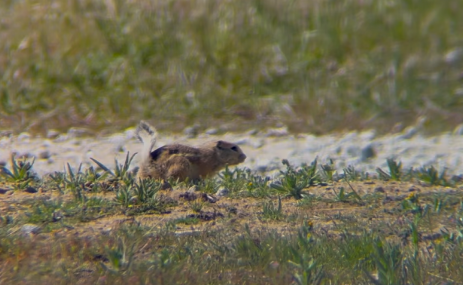
Carrizo Plain Overnight: Squirrels, squirrels
Carrizo Plain Overnight
Squirrels, Squirrels, and More Squirrels!
Carrizo Plain National Monument, Santa Margarita, CA | March 24th-25th, 2025
By minkprowl
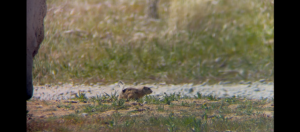
Digiscoped photo of a San Joaquin Antelope Squirrel running away on gravelly terrain.
SPECIES
*Giant Kangaroo Rat (Dipodomys ingens)
Tule Elk (Cervus canadensis nannodes)
California Ground Squirrel (Otospermophilus beecheyi)
*San Joaquin Antelope Squirrel (Ammospermophilus nelsoni)
_______________________
Western Fence Lizard
_______________________
California Quail
Great Horned Owl
Burrowing Owl
Black Phoebe
Say’s Phoebe
Western Kingbird
Common Raven
European Starling
Loggerhead Shrike
House Finch
Lesser Goldfinch
Lawrence’s Goldfinch
Lark Sparrow
White-crowned Sparrow
California Towhee
Western Meadowlark
Yellow-rumped Warbler
*Lifer
EQUIPMENT
- GaiGaiMall-PN-21011 (Red LED flashlight)
- Nikon Monarch 5
- Vortex Razor HD 13-39×56
- iPhone 14
KEY
Text = mammal species mentioned for the first time
Text = important place name
Text = link to an external webpage
Text = bird species mentioned for the first time
REPORT
Honestly, we didn’t see as much as we would have liked to, but I think it’s important to report failure as much as success!
My mom and I entered Carrizo Plain National Monument via the south entrance around 11:00 pm on March 24th. Carrizo Plain is one of our favorite places for wildflowers, but this time, we came to try to find the San Joaquin Kit Foxes.
We drove slowly along Soda Lake Rd, an unpaved road that stretches diagonally across the southeastern to northwestern corners of the reserve (Map), for about two hours.
Within the first half hour, we caught a herd of 12 Tule Elk with patchy hides in our headlights. Chunky Giant Kangaroo Rats also bounded abundantly on the roads both inside and outside the park. They didn’t seem to move very fast, so we thought it best to drive slowly both to better observe other wildlife and avoid hitting them.
I scanned the sides of the road with my red LED flashlight. I caught two pairs of promising eyeshine deep in the sagebrush, but, unfortunately, I couldn’t illuminate the mammals with my flashlight nor our headlights in time to identify them to species. I suspect that my flashlight’s range was too short to catch many of the mammals present in the area (probably because it was a cheap Amazon model), but I was hesitant to spend a lot of money on something as small and easy to lose as a flashlight. For the next outing, I’ll consider investing in a pair of thermal binoculars instead.
The rest of the drive yielded little but Burrowing Owls. The pint-sized, charismatic birds were surprisingly plentiful. They often stood still on the dusty road or adjacent fence posts and stared at us with their large, harvest moon eyes for long periods of time before flying away.
We quit our search once we reached the KCL Campground around 12:00 am. This campground is free and available for car camping; there were only two other cars when we arrived.
Around 9:00 am the next morning, we did some birding and squirrel watching. A colony of California Ground Squirrels has taken up residence at KCL, perhaps because food was readily available? I saw them nowhere else in the reserve during this visit.
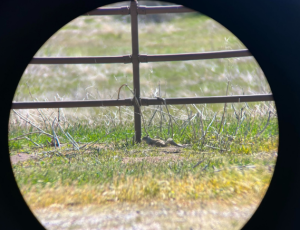
Digiscoped view of a California Ground Squirrel pausing near a fencepost at KCL campground
Once we continued northwest on Soda Lake Rd around 11:00 am, we quickly encountered our next target, the diminutive and threatened San Joaquin Antelope Squirrel. About half the size of its more widespread, aforementioned cousin, the San Joaquin Squirrel was tan with a light “racing stripe” running horizontally along its flank. It seemed to be the dominant squirrel species throughout the rest of the reserve: we saw dozens of them retreating with their short, flat tails over their backs into burrows that kangaroo rats had dug (and the squirrels had adopted). Perhaps they were more abundant because they are better suited to surviving the extreme conditions of the arid grassland? It was a hopeful sight since the species is threatened due to habitat loss and fragmentation caused by agriculture, urbanization, and petroleum extraction (Source).
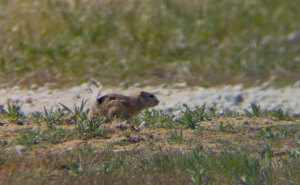
Top/Bottom photo: San Joaquin Antelope Squirrels running to and already in their burrow, respectively
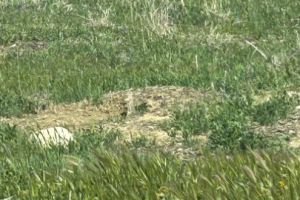
Carrizo Plain March 24-25, 2025 – Mammalwatching.com Report
Post author


Leave a Reply
You must be logged in to post a comment.